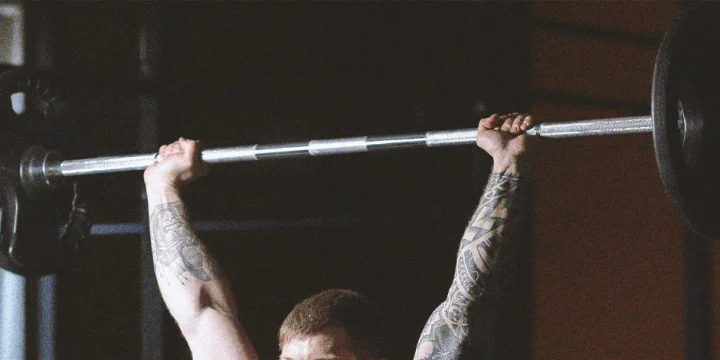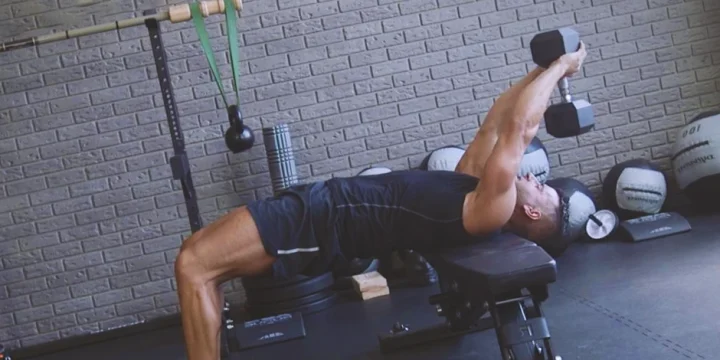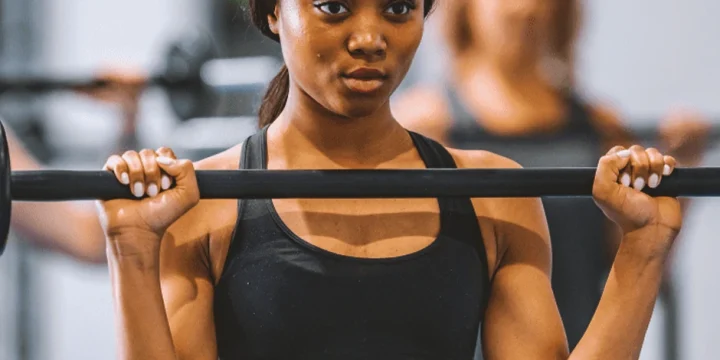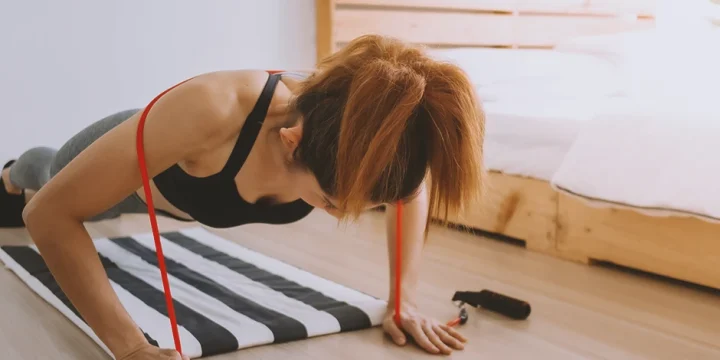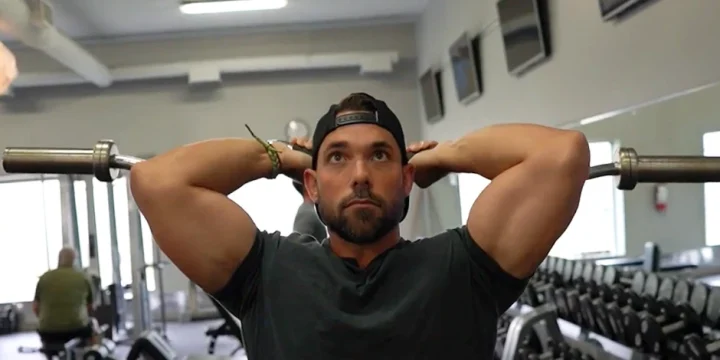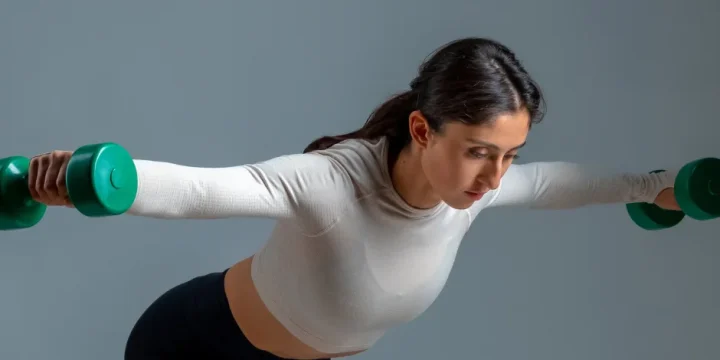Dumbbell deadlifts are one of the best alternative conventional deadlift exercises you can include in your regime to develop lower body stabilizer muscles and posterior chain.
But transitioning from traditional barbell to dumbbell deadlifts might be challenging since many stabilizer muscles aren’t ready for it yet.
Based on my experience as a certified personal trainer and more than 23 hours of research, I compiled all the necessary information to execute the dumbbell deadlift correctly and avoid injuries.
Quick Summary
- To perform the dumbbell deadlift correctly, you must enter the position where your back is flat, knees are slightly bent and fixed during the whole movement, and dumbbells are placed appropriately near your body.
- The best dumbbell and barbell deadlift alternatives include straight-leg deadlift, suitcase deadlift, single-leg Romanian deadlift, single-arm Romanian deadlift, single-arm suitcase deadlift, single-arm and single-leg Romanian deadlift, and sumo deadlift.
- Progressive overload is key to building muscle mass with dumbbell deadlifts, requiring increased training volume over time.
- In my opinion, the dumbbell deadlift is a versatile and essential exercise for both beginners and advanced athletes.
How to Deadlift With Dumbbells: Proper Form

The deadlift works both anterior and posterior lower body muscles, requiring significant effort for proper stabilization and injury prevention.
Here is how to perform the dumbbell deadlift with the correct technique to maximize performance and avoid injuries:
- Pick two dumbbells of appropriate weight so you can perform 6 consecutive reps without making a pause.
- Pick them up and assume a standing position where the dumbbells hang near your body, like in the anatomical position.
- Slightly bend your knees and place your feet in the hip-width stance where the toes look straight ahead (not pointed outward like in the squats).
- Ensure your back (spine) maintains the physiological curvature during the exercise. This means leaving minimal lumbar lordosis, thoracic kyphosis, and cervical lordosis.
- In addition, this type of exercise activates your abdominal muscles such as transverses abdominis, rectus abdominis, obliquus internus, and obliquus externus to ensure spine stability during the entire movement.
- Start the exercise by bending forward in the hip joint, lowering the dumbbells near your body towards the floor, and driving your butt to the ceiling.
- It is crucial here to only bend your knees as necessary, since we want to place the most stress on the posterior chain muscles during the exercise.
- Keep lowering the dumbbells until you reach the bottom position of the lift.
- The bottom position will be different for most people, but you can stop when you reach maximum extension in your glutes and hamstrings while you do this exercise.
- Reverse the motion by pulling the dumbbells upward while keeping your back straight.
- Repeat for 6 reps, 4 sets, and rest for 5 minutes between each set.
Related: Top-Rated Dumbbells for Home Gym
What Is a Dumbbell Deadlift?

The dumbbell deadlift is the lower body pulling exercise performed with an overhand grip.
Dumbbell deadlifts target key posterior chain muscles, including hamstrings, glutes, erector spinae, and back muscles along the spine.
From my experience, the basic dumbbell deadlift targets lower body muscles and engages the upper body and core, creating a synergistic effect that stabilizes the entire movement.
Dumbbell deadlifts are easier to learn than traditional deadlifts yet demand greater stabilizer strength for proper execution.
"When it comes to building fundamental pulling strength, the deadlift is king of the jungle. However, it is also one of the most versatile and customizable exercises out there. If you’re looking for a variation of the deadlift that can build muscle, improve posture, and supplement your main pull all at once, look no further than the dumbbell deadlift."
- Mike Dewar, Certified Personal Trainer
Dumbbell Deadlift Variations - Best Barbell Deadlift Alternatives

Before listing all the alternatives, here are some dumbbell deadlift tips to follow from the National Library of Medicine to get the most out of your workouts:
- Incorporate progressive overload - if you want to build muscle mass or increase lower body pulling strength, then following the principles of progressive overload is a must, as confirmed by the study published on the National Library of Medicine website [1]. This means increasing the sets, reps, external resistance, or total training volume for each following workout.
- Overtraining - you can easily do more than you should and enter the state known as the overtraining syndrome [2]. To avoid injuring your lower back and other posterior chain muscles, it is crucial to have at least 48 hours of rest between exercising the same muscle group again.
- Nutrition and supplementation - eating enough carbs and protein can help you achieve glycogen supercompensation and prepare you for the following intense workout [3]. In addition, it is advisable to eat at least 1 g of protein per pound daily to avoid entering a catabolic state or losing muscle mass [4].
Here are the best alternatives to dumbbell and barbell deadlifts to include in your workout today.
Straight-Leg Deadlift
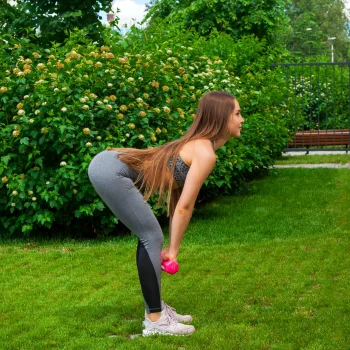
Straight or stiff leg deadlift is an excellent variation for increasing the strength of your lower body posterior chain muscles.
How to Perform Straight-Leg Deadlifts
- Pick two appropriately sized dumbbells to perform 6 consecutive reps without resting.
- Place them in front and assume a standing position, feet hip-width apart and toes pointing straight ahead.
- Slightly bend your knees and don’t move them during the whole movement. Also, keep your back straight over the entire lift to avoid injuries.
- Take the dumbbells to the starting standing position so they are near your body in the anatomical position.
- Start the exercise by bending your hips forward while keeping your knees fixed.
- Lower the dumbbells until they pass the level of your knees, and hold the bottom position for one second.
- Reverse the motion by extending the hip to return to the starting position.
- Repeat for 6 reps, 4 sets, and rest for 3 minutes between the sets.
Suitcase Deadlift
The suitcase deadlift looks almost the same as the regular dumbbell deadlift, but the only difference is that the dumbbells are held in slightly different positions.
How to Perform Suitcase Deadlifts
- Pick two dumbbells of appropriate size so you can perform up to 8 consecutive reps without pausing.
- Assume a standing position, feet hip-width apart, and toes pointing straight ahead.
- Pick the dumbbells from the floor and place them in the suitcase position near your body.
- Start the exercise by bending your hips, knees, and ankles at the same time.
- Also, ensure you do the most bending in your hips since we want to target posterior chain muscles the most.
- When you reach the bottom position, hold it for 1 second.
- Reverse the motion by simultaneously extending the ankles, knees, and hips to return to the starting standing position.
- Repeat for 8 reps, 4 sets, and rest for 3 minutes between the sets.
Single-Leg Romanian Deadlift
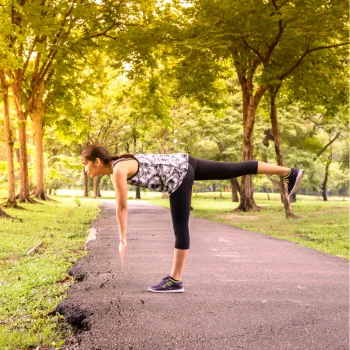
Single-leg Romanian deadlift is one of the hardest posterior chain unilateral exercises that will bulletproof your hamstrings and glutes.
How to Perform Single-Leg Romanian Deadlifts
- Pick two dumbbells of appropriate weight so you can perform 6 reps with each leg without resting.
- Place them in front of you and slightly bend your working (right) knee. Keep the balance on your right leg even though your left leg is still on the floor.
- Pick the dumbbells and place them near the body, like in the anatomical position.
- Start the exercise by lifting the left leg of the floor. Bend forward in your hips so your torso moves towards the floor and your left leg is extended backward and up.
- Hold that position for one second when the dumbbells reach below the level of your knees.
- Reverse the motion by extending the hips to return to the starting standing position on the right leg.
- Repeat for 6 reps for both legs, 3 sets, and rest for as much as needed between the sets to fully recover.
Single-Arm Romanian Deadlift
The single-arm Romanian deadlift is a bilateral exercise performed with one dumbbell, hitting the same muscle groups as the regular ones.
How to Perform a Single-Arm Romanian Deadlift
- Pick one dumbbell of appropriate weight so you can perform 10 consecutive reps without resting.
- Assume a standing position where your feet are hip-width apart and your toes pointing straight ahead.
- Slightly bend your knees and keep them in the same position during the entire movement.
- Hold the dumbbell in your right hand between your legs. The right elbow is fully extended.
- Start the exercise by bending forward in your hips while keeping your back flat and knees in a fixed position.
- Stop when the dumbbell passes the level of your knees for one second.
- Reverse the motion by extending the hips to return to the starting position.
- Repeat for 10 reps, 3 sets, and rest for 3 minutes between the sets.
"If you’re in love with the barbell, power to you. However, if you’re in the mood to change things up but still want to reap the benefits afforded by an exercise considered to be weight-training royalty, head to the dumbbell rack for your next set of deadlifts."
- Bree-Anna Burick, Certified Personal Trainer
Single-Arm and Single Leg Deadlift
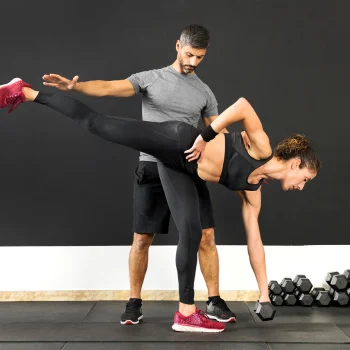
The single-arm and single-leg Romanian deadlift, similar to the single-leg version, is performed with a dumbbell in one hand for contralateral training.
How to Perform a Single-Arm Romanian Deadlift
- Pick one dumbbell of appropriate weight so you can perform the same amount of reps as with the previous exercise.
- Assume a standing position on both legs, but shift your balance to the working-right leg and make your left leg “lighter”.
- Hold the dumbbell contralaterally, so it is in your left hand if the right leg is working and initiating the movement.
- Start the exercise by lowering your torso and dumbbell towards the floor and extending your left leg backward and up.
- Hold that position for one second when the dumbbell passes the level of your knees.
- Reverse the motion by extending the hips to return to the starting standing position.
- Perform the same amount of reps, sets, and rest intervals as for the single-leg Romanian deadlift exercise.
Related Articles:
Sumo Deadlift
The Sumo deadlift is the best dumbbell variation for activating inner thigh stabilizer muscles.
How to Perform a Sumo Deadlift
- Pick two dumbbells of appropriate size so you can perform at least 8 sumo deadlifts without pausing.
- Pick the dumbbells and place them in the hanging position in your hands. They should be placed between your legs.
- Assume a standing sumo deadlift position where your feet are wider than shoulder-width apart, and your toes point slightly outward to achieve a deeper deadlift position.
- Slightly bend your knees and keep them fixed during the whole movement.
- Start the exercise by bending forward in your hips while keeping your back flat and your knees fixed.
- When two dumbbells reach the bottom position or end range of motion, hold that position for one second to achieve a better stretch in your hamstring, glutes, and inner thighs.
- Reverse the motion by extending the hips to return to the starting standing exercise position.
- Repeat for 8 reps, 4 sets, and rest for 4 minutes between the sets to fully recover.
Key Dumbbell Deadlift Benefits

Here are the most important dumbbell deadlift benefits.
Strengthens Posterior Chain
Dumbbell deadlifts, but any deadlifts, too, are excellent for strengthening your posterior chain muscles.
These muscles include the biceps femoris, semitendinosus, semimembranosus, glutes, and erector spinae.
These muscles also reduce injury risk by stabilizing movements in the sagittal and frontal planes.
Strong posterior chain muscles are especially important for athletes in running sports since they often need to accelerate and decelerate.
All these motor actions require substantial effort from the stabilizer and posterior chain muscles.
Supports Everyday Function
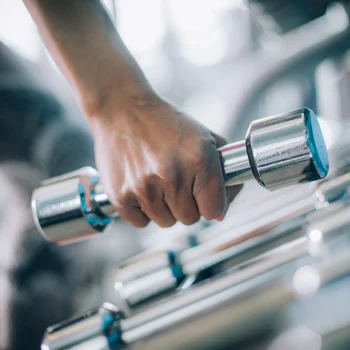
Deadlifts are considered a functional exercise since they follow the hip-hinge functional movement pattern.
Sometimes, the hip hinge is also called the deadlift movement pattern.
This pattern is essential in our daily activities, such as lifting groceries from the floor, picking up our kids, or similar movements.
If we get a strong hip-hinge pattern, most back issues and pain will disappear naturally.
This is why strengthening posterior chain muscles through functional movement patterns such as the deadlift is crucial.
Improves Grip Strength
Deadlifts are notorious for strengthening your grip, and the best thing about having a strong grip is they are an excellent predictor of longevity and current health status [5].
In addition, having a strong grip is also useful for daily activities such as carrying heavy bags, a small kid, or even holding the entire sofa while moving it to another room.
A strong grip will also translate beautifully to other exercises, such as rows and pull-ups.
Lastly, grip strength is closely tied with the forearm width, which is seen as a positive masculine trait that boosts confidence.
Also Read: How to Improve Grip Strength
FAQs
Are Deadlifts With Dumbbells Effective?
Yes, deadlifts with dumbbells are effective. Dumbbell deadlifts are excellent functional exercises that allow you to achieve a maximum range of motion at joints without sacrificing the work of stabilizer muscles that are often neglected on machines and less conventional fitness equipment.
How Much Weight Should I Deadlift With Dumbbells?
It depends on your fitness, age, fatigue level, and many other factors on how much weight you should deadlift with dumbbells. However, the basic rule you can follow to avoid being left behind is to lift at least 60% of your barbell deadlift one rep max to build stabilizer muscles holistically.
Why Are Dumbbell Deadlifts So Hard?
Dumbbell deadlifts are so hard because they require much more stabilizer muscle work than regular barbell deadlifts. In addition, the weight is much better spread when performing a conventional barbell deadlift compared to the dumbbell sumo deadlift or any other deadlift variation with such equipment.
What’s Better Deadlifts or Squats?
Both deadlifts and squats are foundational lifts that should be incorporated into the same workout plan to build lower body anterior and posterior chain muscles holistically and in a balanced manner. However, a conventional deadlift is better for building posterior chain muscles such as hamstrings and glutes, while squats are better for developing quadriceps and specific hip flexor muscles.
What Is the Hardest Part of Deadlift?
Determining which part of the deadlift is the hardest depends on your morphology, bone length, and joint structure. However, the bottom of the deadlift will almost always be the hardest part to perform due to the negative biomechanical position your body needs to overcome to pull the barbell upwards.
How Can I Lift More Weight While Deadlifting?
It would help if you used proper programming and supplementation to lift more weight while deadlifting.
Creatine is one of the best and most affordable supplements to instantly boost your deadlift personal records in a matter of weeks.
It supplies the fastest energy system in the body called creatine-phosphate, which synthesizes adenosine triphosphate (energy) during high-intensity anaerobic activities.
I suggest reading our guide on the best creatine supplements to pick the best one to serve your goals and needs.
Let me know the most challenging thing you face when performing deadlifts with dumbbells.
References:
- https://www.ncbi.nlm.nih.gov/pmc/articles/PMC4215195/
- https://www.ncbi.nlm.nih.gov/pmc/articles/PMC3435910/
- https://pubmed.ncbi.nlm.nih.gov/3698159/
- https://www.ncbi.nlm.nih.gov/pmc/articles/PMC5852756/
- https://www.ncbi.nlm.nih.gov/pmc/articles/PMC5750866/
About The Author
You May Also Like
